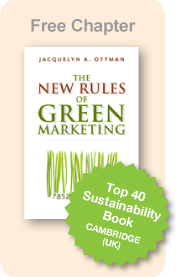Jacquie Ottman's
Green Marketing Blog
Focus On Consumer Self-Interest to Win Today’s Green Customer
October 05, 2011 by Jacquelyn Ottman
If your green ads showcase the now tiresome images of babies, daisies, and planets, your messages will likely be irrelevant to mainstream consumers. Eco-imagery may have tugged at the purse-strings of “deep green” consumers, but their lighter green counterparts, who make up the bulk of the market, want to know how even the greenest of products benefit them personally. While the environment may be the underlying reason a product was created or upgraded, it will likely not be the primary motivation for consumers to choose your brand over those of competitors.
Avoid green marketing myopia
In other words, don’t commit the fatal sin of “green marketing myopia”. As my colleagues, Ed Stafford and Cathy Hartman of the Huntsman Business School of Utah State, and I point out in our much-quoted article, “Avoiding Green Marketing Myopia,” remember that consumers buy products to meet basic needs - not altruism.
When consumers enter a store, they don their consumer, not citizen caps. They are looking to find the products that will get their clothes clean, that will taste great, that will save them money or that will make themselves appear attractive to others. Environmental and social benefits are best positioned as an important plus that can help sway purchase decisions, particularly between two otherwise comparable products.
Quiet Green Marketing
Underscoring the primary reasons why consumers purchase your brand - sometimes referred to as “quiet green” - can broaden the appeal of your greener products and services way beyond the niche of deepest green consumers. Quiet green might also help overcome a premium price hurdle. So, focus communication for greener products on how consumers can protect their health, save money, or keep their home and community safe and clean. Show busy consumers how some environmentally inclined behaviors can save time and effort.
To be clear, this does not mean focusing exclusively on such benefits - to do so would be to go back to conventional marketing altogether. But focusing too heavily on environmental benefits at the expense of primary benefits will put your product in the green graveyard, buried under good intentions. Happily, thanks to advances in technology, many greener products these days do provide added value in the form of enhanced benefits.
Does your green product improve health?
Keep in mind that the number one reason why consumers buy greener products is not to “save the planet” but to protect their own health. Categories most closely aligned with health are growing the fastest and tend to command the highest premiums. Health messages can apply to a wide variety of product categories. Consider, for instance, a print ad for AFM Safecoat (that ran here in the U.S.) featuring 16 buckets of paint; 15 of the buckets are painted red and bear labels such as “Gorgeous Paints,” “100% Pure,” “Low Odor,” and “Sustainable.” However, the last bucket stands out in green and announces “The Only Paint that is Doctor Recommended.”
Does your product appeal to the style-conscious?
American Apparel was created as a brand that provides excellent working conditions for its employees and uses organic cotton. But, in 2004, when its “sweatshop free” label did not bring in the numbers that CEO Dov Charney was hoping for, he switched to promoting a sexy, youthful image for his company - complete with racy, controversial ads with young women. Three years later, the company has 180 stores and revenue estimated at $380 million. Sounds heretical? Keep in mind that the same sustainably responsible clothing is still being sold to consumers, together with all the same benefits to society and the environment.
Does your product save consumers money?
Many brands find that their green benefits neatly translate into something direct and meaningful to the customer, such as energy savings translating into cost savings. Ads for Sears’ Kenmore’s HE5t steamwasher state that it uses 77% less water and 81% less energy than older models. The headline grabs readers with the compelling promise, “You pay for the washer. It pays for the dryer.” In New Jersey, Marcal’s Small Steps campaign positioned the use of 100% recycled household paper products as an easy measure to take for the environment and save money.
Today’s consumers want to know the back-story about products and packages, so focus on primary benefits in the context of a full story that incorporates the environment as a desirable extra benefit. Better yet, integrate relevant environmental and social benefits within your brand’s already established market positioning, and you’ve got the stuff for a meaningful sale.
—-
Jacquelyn Ottman is an expert adviser on green marketing to Fortune 500 companies and the U.S. government. She is the author of four books on green marketing, including the recently released The New Rules of Green Marketing (Berrett-Koehler, 2011) from which this post was excerpted.
Recent blog posts:
• Why Empowering Children is to Key to Green Marketing Success
Subscribe to Jacquie Ottman’s Green Marketing Blog.



 ShareThis
ShareThis

